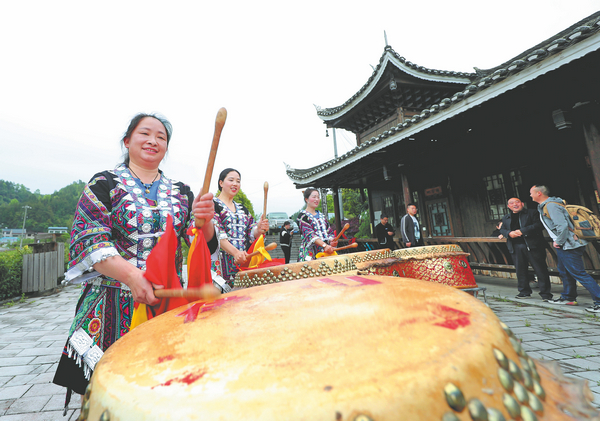

Products launched
Zhang Yan, an official at the provincial culture and tourism department in Zhejiang, said intangible cultural heritage now features at more than 160 major tourist attractions and a dozen tourist routes in the province.
Some 300 tourism products highlighting this form of heritage have also been launched annually, Zhang Yan said.
In Hunan province, Wang Peng, an official at the cultural and tourism department, said the authorities have advanced the development of intangible cultural heritage workshops, as well as villages, towns and blocks — all with cultural heritage features. These efforts have resulted in a significant rise in the number of tours to suburban and rural areas, Wang added.
Sun Jie, CEO of online travel agency Trip.com Group, said tourists are no longer content with merely sightseeing, but also want to pursue intangible cultural heritage experiences in which they can interact with inheritors and learn about them.
The agency is enhancing cooperation with destinations nationwide to help create popular tours by combining intangible cultural heritage and tourism, Sun said.
The Ministry of Culture and Tourism has called for efforts to promote the integration of intangible cultural heritage and the tourism industry on a wider scale and at a higher level.
A circular issued by the ministry in February said such integration must only proceed on condition that cultural heritage is effectively protected.
The circular lists eight primary tasks, which include tourist product development, protecting cultural ecology, fostering tourist routes, and training personnel. It encourages the integration of intangible cultural heritage or relevant elements with tourist sites, including theme parks and hotels.
The China Intangible Cultural Heritage Protection Association recently unveiled 200 models for integrating such heritage and tourism nationwide.
The models, which include scenic spots, tourism towns, blocks and villages, are expected to provide reference points for future culture and tourism integration, the association said.
Wang Xiaofeng, the association's president, said some 14,000 scenic sites rated "A" or above across China are important for showcasing and promoting cultural products, including intangible cultural heritage.
"The best protection for this heritage is to incorporate it into modern people's lives. An influx of tourists results in a greater need for intangible cultural heritage," he said.
Li Xinjian, executive president of Beijing International Studies University's Institute of Culture and Tourism Development, called for all those involved to choose intangible cultural heritage based on tourist needs, and use it to empower the industry and increase its added value.
The most important thing is to provide people with enjoyment and make intangible cultural heritage interesting for them, Li said.
Culture must also be disseminated appropriately through tourism, and the latter made more meaningful, he added.
yangfeiyue@chinadaily.com.cn